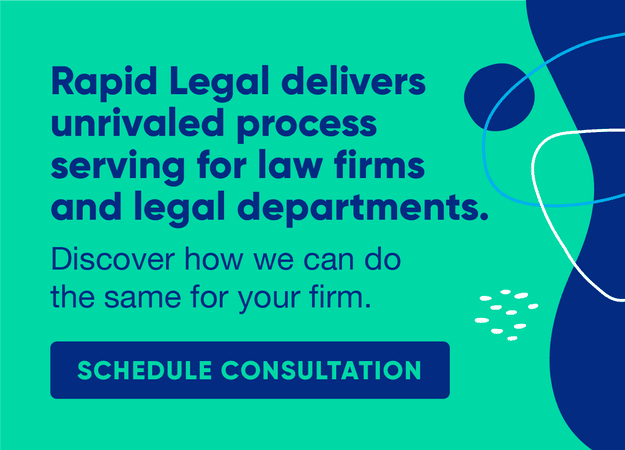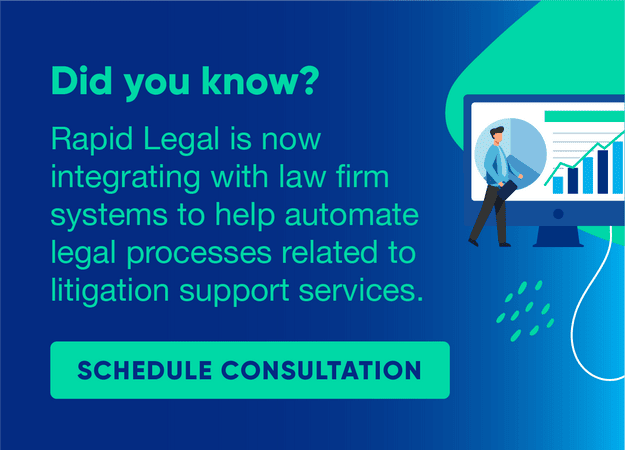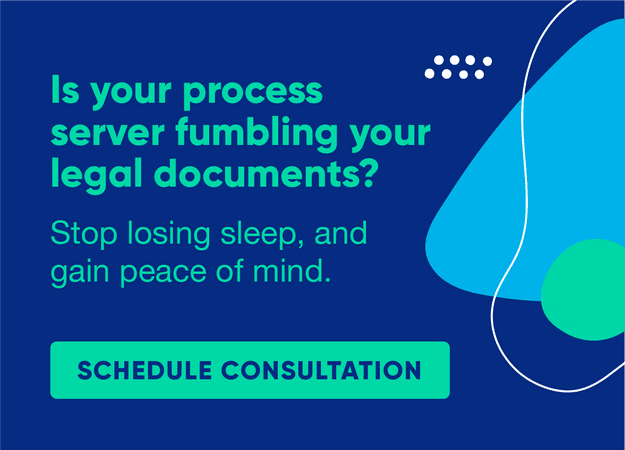How Law Firms Can Get Better eFiling Pricing and Service with a Single, Preferred Provider

It might sound counter-intuitive because competition and using multiple vendors drives down prices for customers, right? Think again.
We didn’t invent the supply chain, but we’d like to settle an important question about it: For eFiling services are you better off using a single, preferred vendor or multiple vendors?
The question is as old as supply chains themselves and the answer may be a simple one in many industries, but in the world of law firms the choice is more complicated. Law firms stand apart from other industries because of the complexities that permeate legal processes. Likewise, those intricacies transfer to the eFiling “supply chain”.
Selecting a good eFiling service provider is a critical decision for law firms. A poor-performing vendor can rob a firm of precious time and money as well as damage its reputation.
79%
Percentage of organizations that achieve significantly above-average revenue growth because of superior supply chain capabilities.
Good vendors are good for growth.
To help guide you toward the right choice we’ve created a short list of advantages for the two models you’ll want to compare. First is the single, preferred vendor model, in which a firm selects one vendor from among many that provide similar services. Second is the multiple vendor model, in which a firm selects two or more vendors that provide similar services. As you learn about these models, consider how each one complements your firm’s business goals.
Single, Preferred Vendor Advantages
Pricing Discounts
Strategic buyers spend to win, and they know that getting discounted prices on eFiling services helps achieve success. When a law firm spreads its dollars among multiple vendors, it can make volume-based discounts difficult to earn. In contrast, directing that spend to a single, preferred vendor substantially increases your firm’s value and makes it more likely that vendor will offer you a volume discount.
From a strategic standpoint, amplifying spend not only places you in a stronger position to ask for volume discounts, but it also makes it more likely you’ll receive additional perks such as hands-on, personalized customer care, or first access to new technologies.
But why restrict pricing discounts to eFiling? A normal business day for your firm probably includes process service, document retrieval, courtesy copy delivery, county recording, and more. Finding and using a single, preferred vendor who excels across the board in litigation support enables you to manage many services easily from one account.
And, more importantly, because of the volume of your work is spread among several different services, you expand the number of services on which you may receive pricing discounts.
More Time for Billable Tasks
Billable hours are the lifeblood of any law firm and every minute that staff members spend on overhead tasks drives up the cost of doing business. Over time, a law firm may lose significant amounts of billable hours to activities associated with the multiple vendor model. Those activities include time spent managing vendors, inefficient communication, system incompatibilities that hinder integration, and monitoring the quality of work from several sources.
There are also short-term and startup activities that cut into billable hours such as conducting vendor interviews, soliciting bids, and learning a new vendor’s systems. Using a single, preferred vendor model dramatically reduces billable hours lost to these activities.
Another important advantage to working with a single vendor is that litigation support staff train only once on a vendor’s system and can repeat those tasks many times. This makes each staff member more efficient, and thus, productive over the long run improving the firm’s return on investment.
Many firms may also find it difficult to reconcile billing with multiple vendors, which will drain billable time from staff, in addition to time lost to managing the operational details of each vendor relationship.
Visualize Better Performance through Partnership
Selecting a single, preferred vendor means both the firm and the vendor commit for the long term – participating in a true partnership. That commitment provides an incentive for the vendor to optimize every aspect of the customer’s experience, from the online portal interface to customer support and billing. And, when you choose to work with a vendor who sees you as a true partner, you unlock the potential for system-to-system integrations that will save you even more time and money.
How much more? The answer depends on your needs and creativity, but here is an example: You make reconciling invoices and expenses for fee motions so efficient that it saves the cost of one full-time employee.
How is that possible? One way is to pull data directly from your single, preferred vendor’s litigation support services platform directly to your own law firm’s system. If you’re using a multiple vendor model chances are slim those types of synergies will be offered to you.
eFiling is just one point on the compass where the benefits of a single, preferred vendor partnership begin. Firms can use this relationship to automate workflows, automate cost control and visibility, eliminate data duplication of entry, and improve many different business outcomes.
The net result for your firm is a consistent level of service, quality, and favorable costs that set up your own clients for a high level of satisfaction. If you have a vision for improved performance across the board, this model can help make it real.
Benefits of Using Multiple Vendors
There is a lot to like about partnering with a single, highly efficient vendor, but there are also distinct advantages to working with multiple vendors. Here are three that deserve a close look.
Safety Net for Your Work
Service disruptions lurk in the shadows of every industry and tend to appear when you least expect them. Natural disasters, power outages, and ransomware attacks are just a few examples of events that can at least temporarily bring your eFiling vendor’s productivity to a screeching halt.
Using multiple vendors for eFiling can minimize the risk of service disruptions by enabling a law firm to transfer its work from one vendor to another. This can be helpful not only as a response to a hurricane or ransomware attack but in the more likely event that a vendor’s service, quality, or performance falters and threatens your eFiling supply chain.
While having multiple vendors spreads out the risk of service disruption, it’s important to ask yourself which is more probable: a disruption caused by a force of nature, technology breakdowns, or a business closing shop? If you have a single eFiling vendor whose services are web-enabled and operate in the cloud, chances are your eFiling will continue uninterrupted regardless of the weather or server-side attacks.
Get a Better Bargain
Pitting rivals against each other is a time-tested business strategy that has survived simply because it works. When several vendors know they are competing for your firm’s business, each one must offer a compelling reason for you to choose its brand. Many times, that reason is price, and a vendor that offers a favorable price likewise offers you a tool you can use to drive a competitor’s price lower.
In the long run, however, this strategy may backfire if a vendor that delivers jaw-dropping low prices in the beginning becomes complacent and allows those prices to rise—or allows its quality to slip. It’s important to monitor price-driven deals over time to make sure the quality and value of service remain consistent.
Give Yourself Room to Move
In the same way that multiple freeway lanes help smooth the flow of traffic, stacking your supply chain with multiple vendors safeguards against bottlenecks. Protecting against jammed workflows is especially important for eFiling but it is also vital for litigation support services that may require human intervention, such as expert document review, process serving, or skip tracing.
For these types of tasks, the multiple vendor model provides a built-in safety valve that allows firms to simply shift work from the underperforming vendor to an alternate vendor. This is done without jeopardizing capacity, and the transition is undetectable to the law firm’s clients. Such a move may, however, may force you to use eFiling providers that are difficult for you to manage or do not offer data you can use to benchmark their services.
Best of Both Worlds
Firms that like the flexibility of multiple vendors but also want the reduced administrative costs and potential volume price incentives of a single vendor may find a middle ground by using a single, preferred vendor that excels in several areas. This “best of both worlds” scenario may be attainable from a single provider that has an established history you can confirm independently.
So, how do you make those confirmations? It’s simple; just ask the vendor and its current clients about the following:
- How many courts does the vendor eFile with directly?
- Can you place multiple order types though a common workflow?
- Does the vendor have a high eFiling court acceptance rate?
- What is the vendor’s accuracy of service?
- Does the vendor have world-class hosting capability that offers scale, performance, security, and compliance?
If you need even greater assurance that a single eFiling vendor can provide the reliability you need, look for one that offers a satisfaction guarantee. A vendor confident enough to say, “If service is not done right, it’s free,” is a vendor that takes client satisfaction seriously.
First Time eFiling? Download This Guide
The transition from traditional paper filing to electronic filing is easier than you think. Download our eFiling Beginner’s Guide to learn:
- How eFiling Works
- How to Prepare for eFiling
- How to meet court eFiling requirements
It is recommended for eFiling beginners as well as those with experience.
Your Choice in a Nutshell
At the end of the day, the best way to understand which vendor is right for you is to clearly understand your own firm’s needs. Then, determine which vendor can fulfill those needs at a sensible and sustainable price. Once you make your choice, monitor the relationship to make sure the vendor delivers as promised.
To help you prepare for your vendor interviews be sure to read 6 Things to Look For In An Electronic Filing Service Provider (EFSP) for insightful questions you can ask about service performance, domain experience, software capability, and more. If process serving will also be a consideration in your vendor search you’ll find a battery of helpful tips to guide your interview questions in What to Look for When Hiring a Process Serving Company.
The best vendor model to choose will almost always be the one that aligns with your firm’s business strategy. Regardless of which model you choose, 21st century law firms that select an eFiling vendor with whom they can leverage innovation and common goals is the one with whom they most likely will experience a win-win.
You’ve Just Scratched the Surface
Our sales team can help find even more ways to transform your court eFiling into a strategic asset for your firm. Book a demo or schedule a call with a Rapid Legal team member to learn how the full scope of Rapid Legal’s portal capabilities can work for you.
6 Things To Look For In An Electronic Filing Service Provider (EFSP)
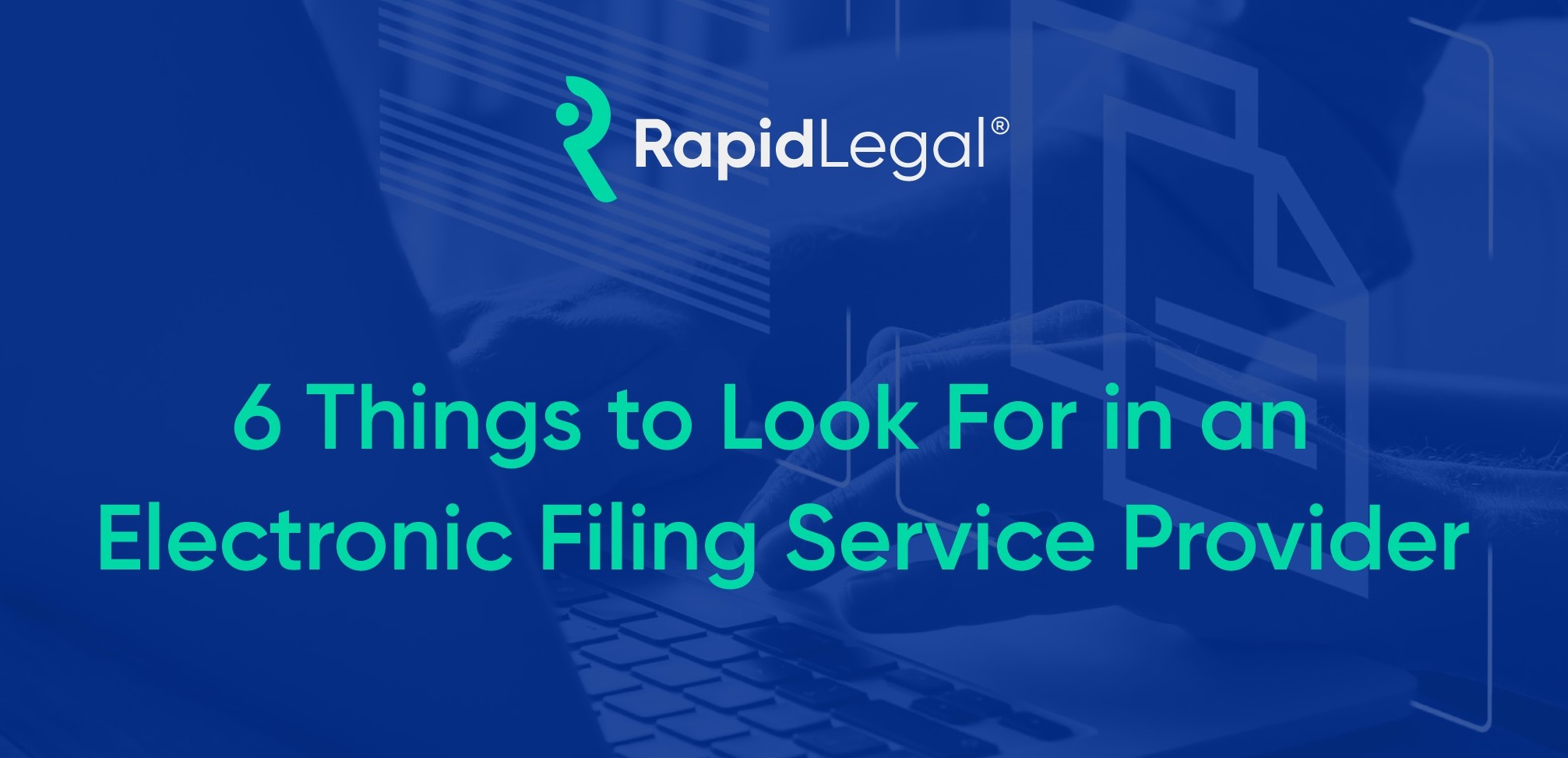
In cases where eFiling is mandatory or permissive, courts in California typically require legal professionals and self-represented litigants to electronically file legal documents with them using an electronic filing service provider, or EFSP. EFSPs are expected to follow proper procedural requirements in a timely and accurate manner, otherwise, their client’s hearings could be delayed, or worse, their cases could be jeopardized.
What is an EFSP?
An EFSP is an Electronic Filing Service Provider that has been authorized and certified by a court, or the court’s technology provider, to integrate its software with the Court’s Case Management System (CCMS) or Electronic Filing Manager (EFM) to transmit and receive data, legal documents, and payments on behalf of end users – law firms, corporations, and the public at large.
EFSPs offer varying degrees of services, technological capabilities and expertise, including the number of court eFiling integrations, customer support, and breadth of litigation support services. It is critical to choose one that can mitigate risk while driving your firm’s innovation forward.
In this buying guide, you will learn six important factors to keep in mind when evaluating an EFSP and finding the right one for your organization.
#1: Service Performance
- Has processes and technology in place that maximize eFiling court acceptance
- Returns court-stamped documents and proofs according to the company’s Service Level Agreements on a consistent basis
- Shares performance metrics with customers such as eFiling Turnaround Times, Serve Success Rates, User Behavior and Order Data
Why It Matters: An EFSP that delivers reliable and transparent litigation support services ensures your filing and serving needs will be well-supported.
#2: Domain Experience & Expertise
- Possesses deep knowledge of CA state & local court rules, industry eFiling systems, and eFiling procedures
- Has several years of experience in your particular geographic location
- Offers complementary services and expertise in other areas such as courtesy copy delivery, records retrieval, and court research
Why It Matters: Where you are eFiling matters, and an EFSP that’s experienced in your area’s specific court rules and policies will be able to better serve you.
#3: Customer Support
- Offers multiple ways to contact customer support such as live chat, email, and phone
- Provides expert review of all documents to ensure proper formatting, filing, and more
- Delivers regular updates on the status of your legal documents
- Partners with clients and focuses on long-term client success by continually earning client trust in every interaction
Why It Matters: An EFSP that makes customer support a top priority ensures your documents will be filed & served correctly and reachable when you need it.
#4: Future-Ready Technology & Software Capability
- Is integrated with all eFiling courts, not just a few of them
- Provides an intuitive portal that is easy-to-use and delivers court-stamped documents and proofs of service back quickly and reliably
- Delivers custom reports and analytics
- Has the ability to integrate with accounting, practice management systems and more, to automate legal workflows and leverage data
Why It Matters: An EFSP that delivers more than just an eFiling portal, but also can leverage data, insights, and integrations to automate and better run your business means it can support you now and well into the future.
#5: Billing Processes
- Has clear and timely billing procedures
- Offers a seamless payment process tailored to a customer’s needs
- Provides in-depth itemized invoices including available payment methods, amount owed, unique invoice reference numbers, and more
- Answers any outstanding questions regarding service and court fees
Why It Matters: Detailed invoices and timely billing from an EFSP delivers greater cost visibility and control for your firm.
#6: Social Proof & Industry Reputation
- Has a proven track record of customer success and satisfaction
- Shares client testimonials on website and social platforms
- Has industry recognition from legal professionals and organizations who have partnered with the EFSP
- Offers case studies that showcase the EFSP’s former work
Why It Matters: Positive reviews from customers and other legal professionals prove an EFSP’s ability to provide reliable services.
Let’s Get Started
Now that you know what to look for in an EFSP, you’re ready to begin your search. For those needing to deliver legal documents fast and reliably, Rapid Legal is here to help. Create an account and start the eFiling process with us today.
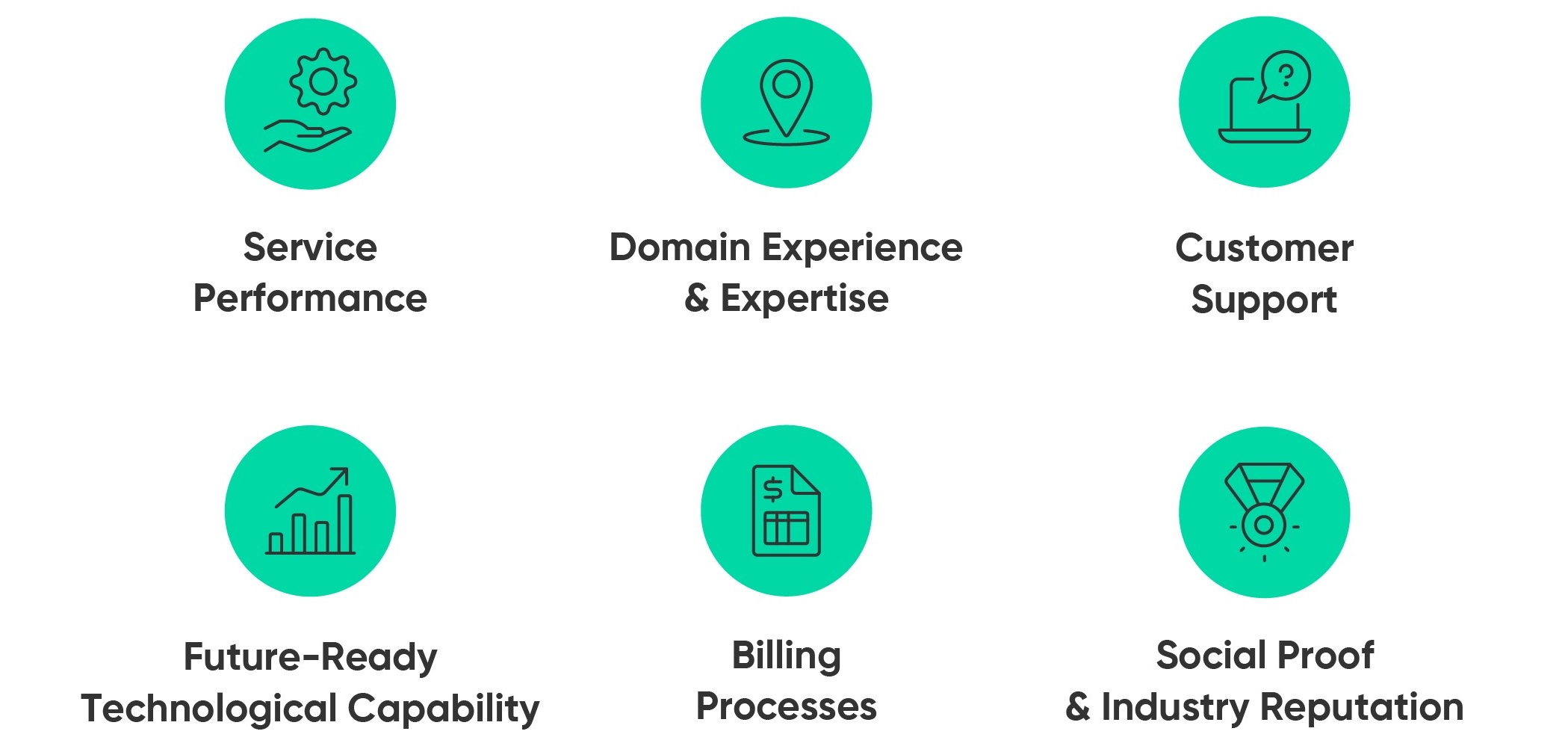
What to Look for When Hiring a Process Serving Company

Office administrators and other legal professionals know there are strict rules for serving court papers. So, when they hire a process server for their law firm or corporate legal department, they expect the proper procedural requirements to be followed in a timely and accurate manner, otherwise, their client’s hearings could be delayed, or worse, their cases could be jeopardized. Chances are, you have had a bad experience or two with a process server in the past.
How do you make sure to partner with the right one?
Here are some important factors to evaluate when selecting the right process serving partner. Some might even surprise you.
What is a ‘Serve Success Rate’?
The serve success rate is a performance metric in process serving that demonstrates how effective a process server is at successfully serving parties to a case, by the requested service level.
SERVE SUCCESS RATES
Have you ever asked a process serving company what its ‘serve success rate’ is?
A high serve success rate indicates a process server is consistently successful in serving case participants, so it is important to ask them.
If a process server fails to indicate their serve success rate — or refrains from sharing this information with you upon asking — that is a red flag. This metric is central to a process server’s effectiveness, and you should want to know what it is. Anything above 90% is good.
BONUS TIP: Any quality process server is accustomed to working day and night, weekdays, and weekends, to track down parties and successfully serve them. If a person is evading service, your process server should be able to skip trace a party that has moved or cannot be located at the address provided, to increase their odds of a successful serve. You should ask your process server if they provide this service, or how they handle evasive parties.
SPEED OF SERVICE
In addition to discovering the serve success rate, it is also important to understand the speed of service. Speed of service by a process server encompasses, not only how quickly they can get someone served, but also how quickly they can deliver the Proof of Service to you. For example, it could take 10 days to get someone served, and another 3 days to complete and provide the Proof of Service to your firm – you should understand the average length of time required for both of those efforts for an accurate estimation of speed of service.
Another consideration that will impact speed of service is the service level that is chosen for a process serving order.
Process serving companies typically offer different service levels depending on the urgency and/or timing needed for a service of process to be completed. For example, Rapid Legal offers the following service levels:
Standard (1st attempt within 5 days)
Priority (1st attempt within 1 day)
Urgent (Same Day Attempt, if received by deadline)
Customers can also select Rapid Legal’s On-Demand option which will allow their order to receive immediate processing upon submission. A quality process server will provide fast speed of service and offer different service levels to accommodate the time-sensitive matters of legal professionals.
BONUS TIP: Timely communication from a process server is crucial. A superior process server will keep you in the loop throughout the lifecycle of your process serving order – from when the order was received, to when it was first attempted, to any special notes, and when it was served, as well as when a Proof of Service will be delivered and more. Be sure to ask the process serving company how they ensure timely communication with their customers.
SERVICE OF PROCESS PRICING
According to the National Association of Professional Process Servers, most process serving prices fall somewhere between $20 – $100 for a standard level of service (1st attempt within 5 days). Urgent or rush jobs could cost up to 3x more. Process serving costs vary depending on the location of the party being served, number of addresses required to locate the party, service level selected, and more.
While doing your research, it is important to ask the process serving company for a clear price estimate or fee schedule based on your firm’s needs. Let it know if your firm typically needs rush-serves or same-day serves and ask it how many serve attempts it will make at the quoted price. It would also be good to inquire about additional services such as skip traces or stakeouts, and their costs.
As you compare costs for process serving companies, you will likely find some disparity in pricing based on the size and sophistication of the firm. Asking a process server for their serve success rates, speed of service, service levels provided, and other features outlined in this article, will help you decipher which one is right for your organization.
BONUS TIP: Most process serving firms offer bulk pricing for high volumes. If you have a need for 20 serves or more per month, you can likely negotiate a discounted rate for your process serves. The same holds true if you add on other litigation support services.
CLIENT SATISFACTION
Process serving companies that take client satisfaction seriously measure and manage it. They regularly survey their customers to gauge how well they are meeting their customer’s needs and engage in ongoing customer service or operational training with their employees. You should ask a process serving company how important customer satisfaction is to them, how they track it (and if they can show proof of satisfaction scores or reports), and what they do when customers are not satisfied.
BONUS TIP: Read online reviews and client testimonials for the process serving companies you are interested in. Ask colleagues or business associates if they are familiar with any of the firms you are evaluating, and if so, what their feedback is for those firms. You can even ask the process serving company for customer referrals to speak with as part of your due diligence process for a selecting a vendor.
HOW RAPID LEGAL CAN HELP
Since 1994, Rapid Legal has been redefining the litigation support service industry. Place a process serving order with Rapid Legal and have your documents served anywhere in the U.S. using our nationwide network of process servers. Our people and technology work together to maximize court filing acceptance and return court-stamped documents and proofs fast, and reliably. Learn more about how Rapid Legal delivers unmatched process serving and more here.
eFiling for Los Angeles Superior Court – Civil Cases
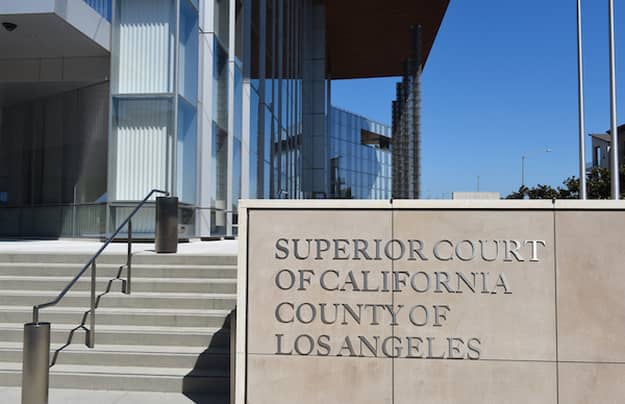
An update on the status of Los Angeles Superior Court (“LASC”) going live with eFiling for Civil Cases.
It is expected that eFiling for Limited Civil Cases will begin in mid-2018, with eFiling for Unlimited Civil Cases sometime late summer 2018. As we get closer to these timeframes we will post updates confirming the Court dates.
Exploring Stakeholders in the California Court eFiling Workflow

There are many key stakeholders that are involved in the submission, transmission and completion of California court eFilings. As a certified Electronic Filing Service Provider (EFSP) for 39 California courts and counting, we examine the main stakeholders of the California Court eFiling system. Who are the players? What are their roles? And why are they important?
California Court eFiling Players and Roles
A high-level overview of a typical eFiling order workflow looks very similar to the image depicted below. We take a closer look at the stakeholders involved throughout the workflow and system.
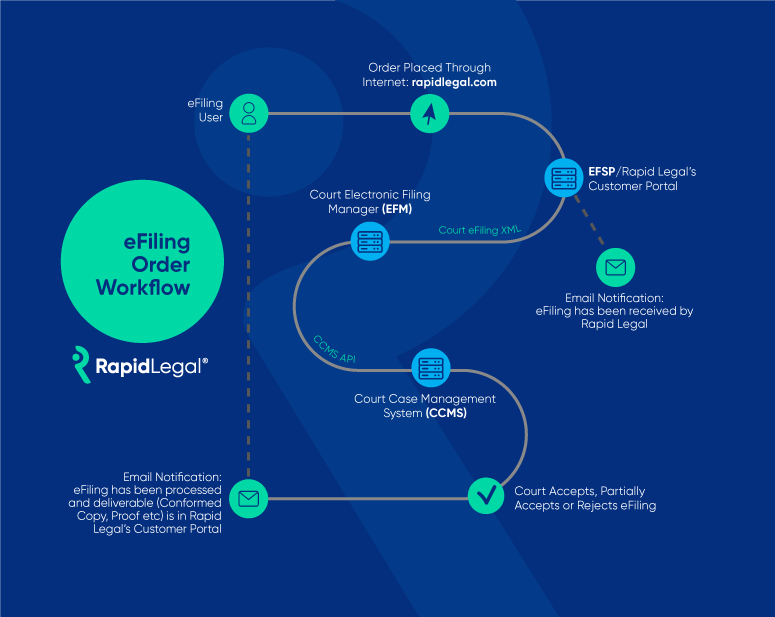
Key Stakeholder 1: The eFiling User
An eFiling user is a user of the eFile case’s Electronic Filing Service Provider (EFSP) and typically places an order and/or submits the case. This person may be the case initiator or the point of contact throughout the life of the case. There could be many eFiling Users for one case. Examples of an eFiling user include Paralegal, Office administrator, Attorney, Secretary, Pro-pers, EFSP Operations user, EFSP customer, court runner, field agent, and more.
Stakeholder 2: Case Participants
A case will consist of case participants which are people, businesses, or organizations involved in the case. This usually consists of a plaintiff (a person who brings a case against another in a court of law) and a defendant (in a civil suit, the person complained against; in a criminal case the person accused of the crime).
Stakeholder 3: Electronic Filing Service Provider (EFSP)
As mentioned above, an eFiling user places an order via an Electronic Filing Service Provider (EFSP), which is a company whose online portal has been certified to transmit documents to a court via an integration with an Electronic Filing Manager (EFM), such as Tyler or Journal Technologies (JTI). In addition to providing eFiling services, an EFSP also typically provides value-added services, training, and support to eFiling users.
As a certified Electronic Filing Service Provider (EFSP) for over 36 courts, Rapid Legal’s technology is integrated with various court Electronic Filing Managers (EFM). These integrations enable filers to electronically file documents directly with the Court through Rapid Legal’s portal.
Stakeholder 4: Technology Provider of Electronic Filing Manager (EFM) Software
Next, the Electronic Filing Manager (EFM) acts as an intermediate system on the Court’s side. This is the system that receives the filings and processes them for the court clerks to view and manage. The EFM connects to the court’s Case Management System (CMS). All courts must use an EFM to manage their backend system.
Click here to view our handy guide that outlines which Court uses which EFM, whether it is mandatory or permissive, case types for eFiling, and associated costs.
Stakeholder 5: The Court and Case Management System (CMS)
Lastly, the stage following the EFM is the Court’s Case Management System (CMS). This is the Court’s backend system that automates court processes, monitors case activities, and supports decision-making through the use of real-time data and analytics. A case management system consolidates and maintains all the information that is pertinent to a case. Users of the court’s CMS include personnel such as clerks, judicial officers, and judges.
Reference Table: California Court eFiling Stakeholders
| Stakeholder | Definition | Notes | Examples |
|---|---|---|---|
| eFiling User | A User of the eFile case’s Electronic Filing Service Provider (EFSP) system. | This person may be the case initiator or the point of contact throughout the life of the case. There could be many eFiling Users for one case. | Paralegal, Office administrator, Attorney, Secretary, Pro-pers, EFSP Operations user, EFSP customer, court runner or field agent. |
| Case Participants | People, businesses, or organizations involved in the case; consisting of a plaintiff (a person who brings a case against another in a court of law) and the defendant (in a civil suit, the person complained against; in a criminal case the person accused of the crime). | Self-represented litigants are not required to eFile in California. | Plaintiff, Defendant, (or Attorney, if case participant is represented) |
| Electronic Filing Service Provider (EFSP) | A company whose online portal has been certified to submit documents to a court via an integration with an Electronic Filing Manager (EFM). | An ESFP may also provide value-added services, training, and support for eFiling. | Rapid Legal is an example of an EFSP. |
| Electronic Filing Manager (EFM) | The EFM acts as an intermediate system on the Court’s side. This is the system that takes in filings and processes them for the courthouse clerks to view. The EFM connects to the Court’s case management system (CMS). | All courts must use an electronic filing manager (EFM) to manage their backend system. One of these, in particular, requires filers to connect their Rapid Legal account to the EFM to help with proper tracking of cases, parties, and attorneys associated with cases. | Tyler (Odyssey eFileCA), Journal Technlogies (JTI), etc. California allows each county to select its own technology vendor. Click here to view our handy guide that outlines which Court uses which EFM. |
| Court Case Management System (CMS) | This is the Court’s backend system that automates Court processes, monitors case activities, and supports decision-making through the use of real-time data and analytics. | The stage following the EFM is the court Case Management System (CMS). After your filing has been accepted, your documents become a permanent part of the court record. A CMS helps to consolidate all the information that is pertinent to a case. The system also supplies all the tools that may be necessary for a follow up on the matter. | |
| Court | A government institution, with the authority to adjudicate legal disputes between parties and carry out the administration of justice in civil, criminal, and administrative matters in accordance with the rule of law. | Parties that work at the Court may include the clerk, judicial officer, and the judge. | Any courthouse, i.e.: LA County Superior Court, OC Superior Court, district courts, Court of appeals, etc. |
Looking to get started with eFiling? Check out our handy guide that provides an overview of eFiling, some common eFiling reasons to watch out for, a checklist of how to carefully select an Electronic Filing Service Provider (EFSP), and much more.
Ready to create an account? Place an eFile order today.
About Rapid Legal
For more than 25 years, Rapid Legal has helped to define and transform the legal support services industry with its vision and commitment to customers, the courts, and a party’s right to due process under the law.
Trusted by thousands of law firms, government agencies and companies, Rapid Legal leverages its deep industry and technology expertise, and a best-in-class legal services cloud management platform, LegalConnect®, for delivering premium legal support services including electronic filing of court documents (“eFiling”), physical court filings, and service of process.
CA Court eFiling Requirements – Part Three

This is the 3rd and final post in our 3 part series created to answer the question, “What CA courts are moving to eFiling and when?”
Here in Part Three, we bring you the current state of eFiling in San Diego County Superior Court, Alameda County Superior Court and two other honorable mentions: Sacramento and Stanislaus Counties.
San Diego County Superior Court
March 4, 2013: eFiling opened up in San Diego’s Central Division.
June 30, 2014: eFiling opened up in San Diego’s North County Division.
MANDATED:
San Diego Superior Court requires the following actions to be eFiled:
- Provisionally Complex (Antitrust, Construction Defect, Mass Tort, Environmental/Toxic Tort and Securities Litigation Cases)
A couple of caveats exist:
Self-represented litigants are not required to eFile or electronically serve documents in a mandatory eFile case. If they choose to do so, however, they may eFile and electronically serve documents; or they may otherwise be ordered to eFile and/or electronically serve documents by the Court.
A party may, in writing and by ex-parte application, request an exemption, which can only by granted by Court Order. This request must be made to the judge or department to which the case is assigned.
For mandated eFiling cases, San Diego Superior Court has designated One Legal as the court-approved eFiler. For all other cases, Rapid Legal can assist you.
Take Note! The following filings or case types are NOT ELIGIBLE for eFiling, and must be filed in paper form:
- Name Change (Safe at Home) Petitions
- Civil Harassment TRO/RO
- Workplace Violence TRO/RO
- Elder Abuse TRO/RO
- Transitional Housing Program Misconduct TRO/RO
- School Violence Prevention TRO/RO
- Out-of-State Commission Subpoenas
- Undertaking/Surety Bonds
- Requests for Payment of Trust Funds
- Writs, Abstracts, or Warrants to be issued
- Notice of Appeal of Labor Commissioner
- Settlement Conference Briefs (to be lodged)
- Confidential documents lodged conditionally under seal Interpleader actions pursuant to CC2924j
Okay, so maybe you’re still not sure which documents need to be eFiled in San Diego? Feel free to give our team a call at 800.366.5445!
You can also view the Court’s FAQs here.
What’s next for San Diego?
The Court is striving to do more to build out its technology and infrastructure to support e-Filing for all Civil Actions. We’ll keep you posted with new developments as they arise.
Alameda County Superior Court
Alameda Court is preparing for the launch of a new Case Management System for juvenile, criminal, family, civil and probate case types. Juvenile and criminal case types are expected to launch in December 2015, with the remaining to go live December, 2016. The Court intends to implement e-filing concurrently.
How about other Counties in California, you may be asking?
While they are not expected to go to full-fledged eFiling right away, there are two other Counties which show some indication of moving in that direction:
Sacramento County Superior Court
Sacramento County has allowed eFiling for Unlawful Detainers (UDs) and Small Claims for several years now. They have made no other provisions, though, as of this writing. Rapid Legal continues to monitor Sacramento for further developments in e-Filing.
Stanislaus County Superior Court
It is projected that by 2016, Stanislaus will look to roll out eFiling.
Rapid Legal will continue to stay in contact with the Courts. Our aim is to continue providing eFiling to our customers to the fullest extent possible, and as each court makes eFiling available.
Productivity Tip: Save Time with Manage Cases

Are you taking full advantage of all that Manage Cases has to offer within your Rapid Legal account?
Manage Cases saves you time as you are able to place a new order on existing cases without having to re-enter the case information.
All it takes is three easy steps:
- Once you are logged into the Customer Portal, click on “Manage Cases”.

- You can filter the cases with activity within the last 90 days (default view) by typing the Case Name or Case Number in the search box. The list of cases will be filtered as you type in your keywords or numbers.
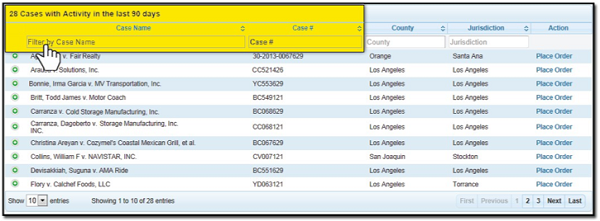
- When your case appears, click on “Place Order” to create a new order on this case without having to re-enter the case information. You can also click on the + icon next to the case name to see orders and documents associated with the case.
| Feature | eFile | eDelivery/eSubmit |
|---|---|---|
| PDF delivery of documents to Court’s Case Management system | Yes | Yes* |
| Receipt of Filing | Within minutes | Usually within 2 business days |
| Integrates with court policies | Yes | No* |
| Single log-in | Yes | No; separate login per court |
| Email notifications | Yes | Yes |
| Fees | An electronic filing service provider (EFSP) pays all fees in advance and sends a single itemized invoice at the end of each transaction | Varies (depending on court, usually convenience fee + credit card processing fee). A credit card is required for each filing |
| Payment Methods | Credit card, eCheck/ACH | Credit card only |
| *Requires court clerk to input into court case management system | ||

It’s really that simple!
In Manage Cases, you are also able to view, print, and download case details, associated orders and documents.
For more details, view our full user guide on Managing Cases and Documents.
Need more assistance on Manage Cases or placing an order? We’re here to help.
-The Rapid Legal Team
operations@rapidlegal.com
P.S. For a limited time, you can schedule a complimentary 15-minute call with a Rapid Legal Account Manager today to get a COVID-19 court update and more.
Did You Know? eFiling vs. eDelivery and eSubmit Are NOT the Same!

Most of us in the legal industry are familiar with, or have at least heard of, “eFiling”, but have you heard of “eDelivery or eSubmit”? More importantly, do you know the difference?
Before we dive into what eDelivery/eSubmit is, it’s important to understand some of the history of how legal documents have been transmitted to U.S. courts throughout the years.
Prior to the digital age, court submissions were done in one of two ways: 1) legal documents were physically filed at the court and 2) they were sent via mail. Later, with the introduction of the fax machine in the 1990’s, fax filing was born. This changed the speed and ease of how documents could be transmitted.
With fax filing, a user would send their legal documents to a Fax Filing Service Provider who would review, prepare, and physically deliver the documents directly to the court or transmit the documents via facsimile to the court. All three of these traditional methods, each with their own advantages and disadvantages, are still being utilized today. The other two methods are eDelivery/eSubmit and eFile, which we will cover a little later.
Methods to File Documents with the Court:
People Still Use the Fax!?!
Believe it or not, there are a number of reasons why we are still using the fax machine in 2020. The fact is, we don’t know if it’s going away anytime soon due to user familiarity, ease of use, and legacy requirements. But it isn’t a method without flaws. What a user may not know is that once a fax transmission is received by the court, there is an entire manual workflow that takes place behind the scenes by court personnel and the timeline varies by each court.
For example, once the fax is received, a court clerk has to manually check the documents for accuracy and completeness, accept them or reject them due to errors, and then manually input them into the Court’s Case Management System (CCMS). This manual effort takes time, is subject to delays due to data entry or workflow bottlenecks and can result in human error. Thus, eFiling and eDelivery/eSubmit were introduced to solve these shortcomings.
What is Electronic Filing (eFiling)?
Electronic filing, or eFiling, is the method of electronically submitting your legal documents to the court via the internet. It typically requires the user to select an approved eFiling Service Provider (EFSP) to eFile their legal documents. Federal, state, and municipal courts have varying rules and regulations for eFiled documents. In many courts, electronic filing is mandatory and they do not allow in-person physical filing.
The biggest advantages of eFiling over traditional filing methods are that it is significantly faster to process, it reduces the amount of paper/manual processes and it’s much more cost-effective, i.e., a physical filing costs $65+ vs. $10 for an eFiling. Traditional filing meant that law firms needed to have a court runner to deliver multiple paper copies of legal documents and pleadings to the corresponding courts and parties.
eFiling is a truly integrated, end-to-end data exchange solution, connecting law firms and EFSPs directly to the courts. This diagram gives a high-level overview of how eFiling works:

Currently, 36 out of 58 counties in California have enabled some level of eFiling in their courts. Starting in 2008, many individual county courts in California such as Orange County, Contra Costa, and Sacramento had begun piloting programs for eFiling.
Because eFiling is a fully-integrated technology solution, the cost/investment, time and expertise needed is significant for the court. Some county courts also don’t have the case volume to justify such an investment. Bear in mind that fax submissions at this point are still actively being used, likely suppressing the need to modernize and go fully digital. Thus, for courts that don’t have the budget, expertise or infrastructure to support eFiling, a new solution called “eDelivery” was developed.
What is eDelivery?
More recently, some county courts that were not ready to make the full transition to eFiling have implemented an interim solution called “eDelivery”. Essentially, a platform – or web portal – allows parties the ability to submit electronic (PDF) versions of documents in place of the original directly to individual courts, similar to how fax filing works.
How Does it Work?
- Electronic (PDF) versions of documents will be submitted by the filing party through a web portal
- Upon receiving electronic document(s), a “Notice of Receipt of Documents” will be sent to the email address provided by the user
- This notice will contain the eDelivery submission number and will confirm that the Court has received the document(s)
- Provided the information supplied is complete and the fees paid are correct, the document(s) will be accepted by the Court and will be filed with the appropriate courthouse as if it had been filed in person
- Upon the acceptance of the document, an email notifying the submitting party of such, along with an electronic conformed copy, will be sent
- A notifying email will also be sent if the document is rejected
Considerations/Limitations
- Not a fully-integrated, automated solution
- Like fax filing, it still requires court clerk to manually input into court case management system
- Speed – receipt of filing is dependent on court
- Separate logins per court
- Fees may vary and a credit card is required for each filing
- Credit card is the only accepted method of payment
So far, four county courts in California are using an “eDelivery” solution: Imperial, Placer, San Joaquin, and Riverside. The latter two mentioned, San Joaquin and Riverside, have implemented their own instance of eDelivery portals. It is important to note, to avoid confusion, that although San Joaquin calls it “eFile” on their portal, that it is essentially an eDelivery portal. Riverside, on the other hand, refers to their portal as “eSubmit” so you might see these two terms used together or synonymously.
eFile vs. eDelivery/eSubmit
Although the terminology may sound similar, eFile vs. eDelivery/eSubmit are completely different processes as the latter is not a fully integrated solution and there is no data-exchange taking place. Essentially, eDelivery/eSubmit is really just a step above fax filing. With eDelivery/eSubmit, once the court receives the submission, the process is essentially the same as fax. A clerk will still need to review the documents, accept or reject, then manually input the information from the PDF into the court case management system.
To help compare some of the other differences between eFile vs. eDelivery/eSubmit, please refer to this chart below:
| Feature | eFile | eDelivery/eSubmit |
|---|---|---|
| PDF delivery of documents to Court’s Case Management system | Yes | Yes* |
| Receipt of Filing | Within minutes | Usually within 2 business days |
| Integrates with court policies | Yes | No* |
| Single log-in | Yes | No; separate login per court |
| Email notifications | Yes | Yes |
| Fees | An electronic filing service provider (EFSP) pays all fees in advance and sends a single itemized invoice at the end of each transaction | Varies (depending on court, usually convenience fee + credit card processing fee). A credit card is required for each filing |
| Payment Methods | Credit card, eCheck/ACH | Credit card only |
| *Requires court clerk to input into court case management system | ||
Which Courts in California offer eFiling or eDelivery/eSubmit?
| County | eFile | eDelivery/eSubmit | Physical Filing-only |
|---|---|---|---|
| Alameda | ✔ | ✔ | |
| Alpine | ✔ | ||
| Amador | ✔ | ||
| Butte | ✔ | ||
| Calaveras | ✔ | ||
| Colusa | ✔ | ||
| Contra Costa | ✔ | ✔ | |
| Del Norte | ✔ | ||
| El Dorado | ✔ | ✔ | |
| Fresno | ✔ | ||
| Glenn | ✔ | ||
| Humboldt | ✔ | ||
| Imperial | ✔ | ✔ | |
| Inyo | ✔ | ||
| Kern | ✔ | ||
| Kings | ✔ | ||
| Lake | ✔ | ||
| Lassen | ✔ | ||
| Los Angeles | ✔ | ||
| Madera | ✔ | ✔ | |
| Marin | ✔ | ||
| Mariposa | ✔ | ✔ | |
| Mendocino | ✔ | ✔ | |
| Merced | ✔ | ||
| Modoc | ✔ | ||
| Mono | ✔ | ||
| Monterey | ✔ | ||
| Napa | ✔ | ||
| Nevada | ✔ | ✔ | |
| Orange | ✔ | ||
| Placer | ✔ | ✔ | |
| Plumas | ✔ | ||
| Riverside1 | ✔ | ✔ | |
| Sacramento | ✔ | ||
| San Benito | ✔ | ||
| San Bernardino | ✔ | ✔ | |
| San Diego | ✔ | ||
| San Francisco | ✔ | ||
| San Joaquin2 | ✔ | ||
| San Luis Obispo | ✔ | ||
| San Mateo | ✔ | ||
| Santa Barbara | ✔ | ||
| Santa Clara | ✔ | ||
| Santa Cruz | ✔ | ||
| Shasta | ✔ | ||
| Sierra | ✔ | ||
| Siskiyou | ✔ | ||
| Solano | ✔ | ||
| Sonoma | ✔ | ||
| Stanislaus | ✔ | ||
| Sutter | ✔ | ||
| Tehama | ✔ | ✔ | |
| Tuolumne | ✔ | ||
| Trinity | ✔ | ||
| Tulare | ✔ | ✔ | |
| Ventura | ✔ | ||
| Yolo | ✔ | ✔ | |
| Yuba | ✔ | ||
| 1 Riverside refers to their eDelivery portal as “eSubmit” 2 San Joaquin refers to their eDelivery service as “eFile” on their website | |||
Last update: June, 2023
Do you still have some questions on the difference between eFiling and eDelivery/eSubmit? Schedule a 15-minute call with a Rapid Legal Account Manager today – we’ll be happy to answer all your questions!
About Rapid Legal
For more than 25 years, Rapid Legal has helped to define and transform the legal support services industry with its vision and commitment to customers, the courts, and a party’s right to due process under the law.
Trusted by thousands of law firms, government agencies and companies, Rapid Legal leverages its deep industry and technology expertise, and a best-in-class legal services cloud management platform, LegalConnect®, for delivering premium legal support services including electronic filing of court documents (“eFiling”), physical court filings, and service of process.
CA Court eFiling Requirements – Part Two

This is the 2nd post in our 3 part series created to answer the question, “What CA courts are moving to eFiling and when?” To view the first post which covered eFiling with Orange County and LA County courts, check this page CA Court eFiling Requirements – Part One.
Here in Part Two, we bring you the current state of eFiling in Riverside and San Francisco Counties.
Please note: This information is current as of January 2015. While we’ve made every attempt to verify its accuracy, you should always consult CCP, local court rules and/or CA Rules of Court. Also, this is only information, not legal advice.
San Francisco County Superior Court
December 8, 2014: San Francisco County Superior Court (SFSC) mandates e-filing for General Civil Actions (including Asbestos, Probate Trust (case numbers that being with “PTR”) and Complex Litigation cases — subsequent filings. Initial pleadings are NOT subject to mandatory eFiling, at this time. It is important to note that limited Unlawful Detainer (UD) Small Claims and Probate Cases – except Trust cases – are not subject to mandatory eFiling requirements.
Need more detail about the local requirements for San Francisco? The eFiling rules are contained in San Francisco Superior Court (SFSC) Local Rule 2.10.
Take note, the following must be submitted in paper form:
Documents issued by the Court, Summons, Order of Examination, Writs, Abstracts; Bonds, Fee Waiver Applications, DMV Certifications, and Sealed Documents. (See SFSC Local Rule 2.10R).
Self-represented parties and non-parties may efile, but are not required to do so. In Probate Trust cases, however, once a self-represented litigant chooses to e-file, such chosen filing method must be used exclusively in that case. (See SFSC Local Rule 14.100 (B))
Can you place your eFiling orders through Rapid Legal? Yes.
Rapid Legal has been granted access to the San Francisco Superior Court’s e-filing portal for all subsequent civil case eFilings.
You can now place your San Francisco eFiling by logging onto your Rapid Legal account and placing a Court Filing order and selecting San Francisco as your jurisdiction. Rapid Legal will verify whether or not your documents are required to be filed electronically or hand delivered and file them on your behalf accordingly.
If you have any questions, give our team a call at 800.366.5445!
Courtesy Copies:
- In Civil cases, courtesy copies are required under SFLR 2.10(T).
- In Probate Trust cases, courtesy copies are required under SFLR 14.100(F).
Worth Noting!
(Another shameless plug)…
With Rapid Legal’s order-assisted e-Filing, you may at the same time request and obtain conformed copies. With the San Francisco Court’s current eFiling configuration, an eFiler still has to have someone separately go to the Court to get any conformed copies.
Still not sure about all of this? Feel free to contact our team! You may also view the Court’s answers to many of the most pressing questions – Check out their FAQs here.
Did You Know? 1 out of 10 eFilings can be rejected by the court.

eFiling rejections continue to plague legal professionals, potentially causing missed statutory deadlines or jeopardized cases.
There are several common reasons court eFiling rejections occur:
- Party’s name does not match the name listed on the initial lead document
- Incorrect case type has been selected
- Incorrect document type has been selected
- Wrong case number has been listed somewhere on the filing
- Wrong court location has been selected
- Issues with the filing itself, like uploading the wrong filing, submitting the filing in the wrong format, having the wrong name on the saved filing, improper scanning, or not including the required attachments.
So, it’s probably not surprising that eFiling rejection rates hover between 10-15%, depending on the court. That equates to 1 – 1.5 out of 10 court eFilings being rejected! What can be done?
To minimize eFiling rejections, we created two solutions – Expert Review and Concierge Service.
What is Expert Review?
Expert Review is a $35 service add-on for eFiling orders that customers can select to enhance court acceptance and to provide extra peace of mind. With this service, a Document Specialist team member will intercept your eFiling before it’s sent to the court and verify the following:
1) Accuracy Check: Verify the case number, parties, signatures, dates, court location, case type and document type.
2) Electronic Assembly: Verify the font style, searchable text, pagination, file size, layout and scan readability.
3) Jurisdictional Requirements: Confirm the filing contains locally required information such as bookmarks and mandated forms
What is Concierge Service?
Just like a hotel concierge that is hired to book a restaurant reservation or purchase show tickets on behalf of their customers – our concierge service operates very similarly. If you don’t have the time or you want to ensure your service is done correctly, you can hire us to perform our Concierge Service for you.
“…I reached out to them and used the concierge service where they have someone in their office look at the documents and say ‘this is ok, this you might want to change’, various issues like that. I forget what the fee was but we were more than happy to pay it rather than having things continually rejected…and they took care of it…it was wonderful…” – Rapid Legal Law Firm Customer
With Concierge Service, you simply upload your documents here and we handle your submission from start to finish:
1) File Assembly: Verify filings basics, physical or electronic assembly
2) Jurisdictional Requirements: Ensure filing contains locally required information such as bookmarks, and mandated forms
3) Service Execution: Complete the order entry in our portal for whatever service you select – electronic or physical filing, service of process, document retrieval, secretary of state filing plus more.
Best of all, our Concierge Service includes built-in Expert Review as part of the service for extra peace of mind.
So the next time you are concerned about court filing rejections, or what court requirements you need to meet (there are state and local county rules to keep in mind), or you’re simply running out of time – remember Rapid Legal has Expert Review and Concierge Service to help you! Let us put our expertise to work for you.
Ready to get started? Click here place your Concierge Service order.
(Please note: Concierge Service is only available to registered account owners. Click here to create an account.)
Want a quick demo first?
Schedule a 15-minute call with a Rapid Legal Account Manager today – we’ll be happy to walk you through how to submit your first Concierge Service or Expert Review request and answer your questions!
About Rapid Legal
For more than 25 years, Rapid Legal has helped to define and transform the legal support services industry with its vision and commitment to customers, the courts, and a party’s right to due process under the law.
Trusted by thousands of law firms, government agencies and companies, Rapid Legal leverages its deep industry and technology expertise, and a best-in-class legal services cloud management platform, LegalConnect®, for delivering premium legal support services including electronic filing of court documents (“eFiling”), physical court filings, and service of process.

Interesting, huh? We’ll talk more about Rapid Legal’s eFiling technology in future posts, but for now, let’s see what’s going in with eFiling in the Los Angeles County courts.
Los Angeles Superior Court
As it stands today, LASC only allows for permissive eFiling for Small Claims. Parties who want to eFile a Small Claims action can do it online through the Court’s website, except when:
- The claim is against a government agency
- The claim involves an attorney-client fee dispute
- The claimant is requesting a waiver of Court fees and costs
- The claimant is a minor, a legally incompetent person, or a person for whom a conservator has been appointed
So maybe you already knew this and you’re asking when eFiling is going to be instituted for other case types at Los Angeles Superior Court? We’ll here’s what we know…
In 2013, LASC appointed a new CEO, Sherri Carter, known for her achievements in technological innovation. Last year, the court hired the Chief Information Officer, Snorri Ogata, from Orange County Superior Court to serve as their CIO. Our guess? LASC is making these types of moves because they’re getting serious about expanding electronic filing. As the largest court system in the nation, LASC’s eFiling expansion will be quite significant and will likely take at least 3-4 years, if not longer, to fully implement.
In our next post in this 3 part series, we’ll be discussing eFiling with San Francisco county courts.

